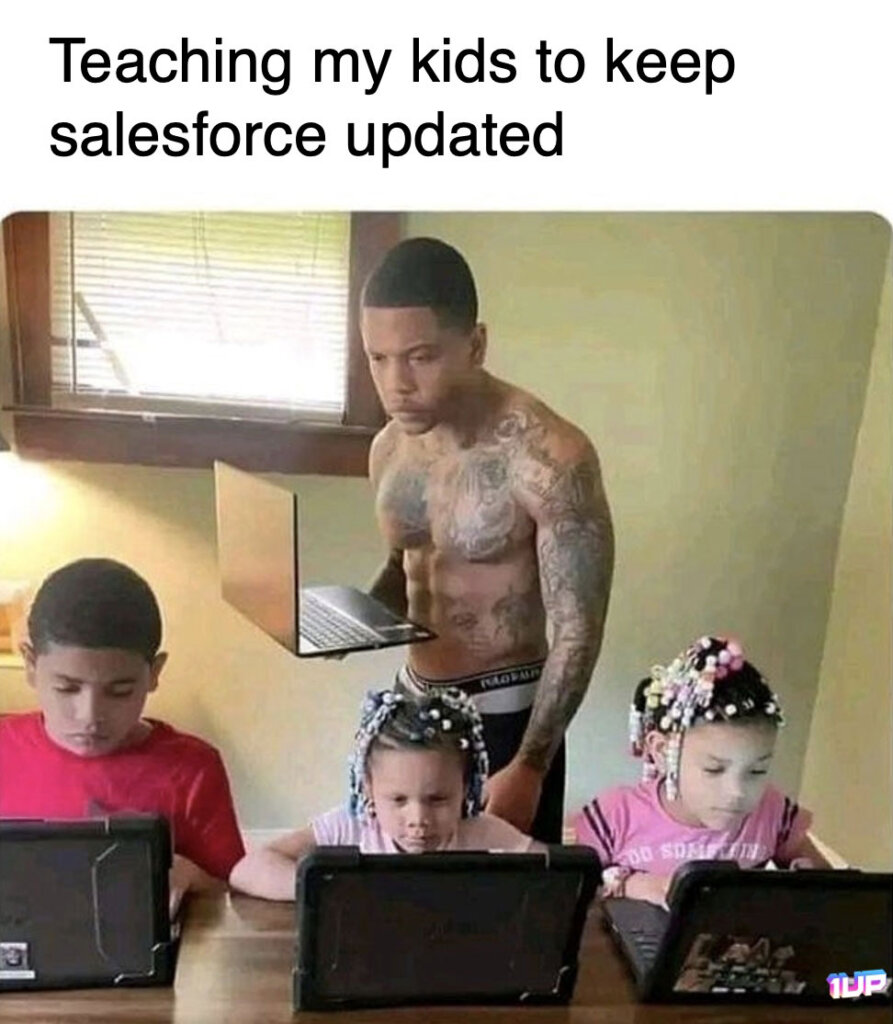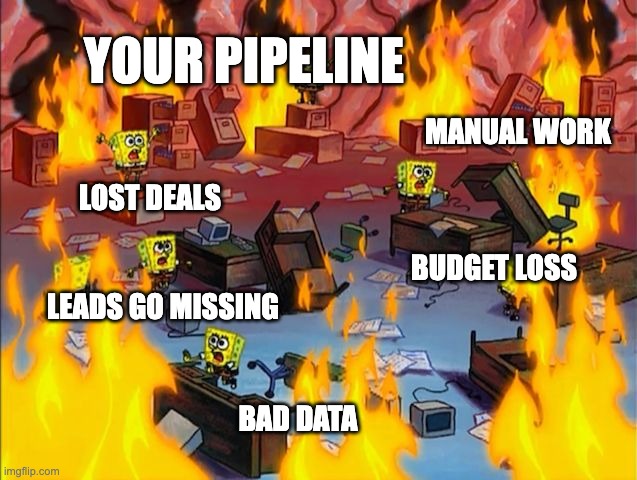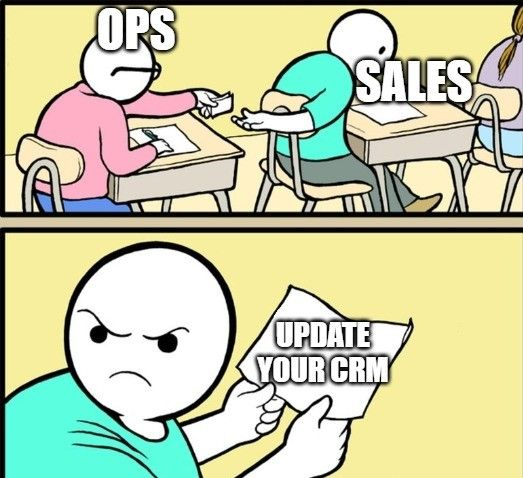
Tired of guessing? Here’s why accurate sales attribution is a game-changer
How often have you said, “We need more leads” or “These marketing leads suck”?
Take a deep breath. The marketing team may not be the problem here (shocking I know).
The real issue? You don’t actually know what’s driving revenue—and what’s not.
That’s where accurate sales attribution comes in. Think of it as your secret weapon for figuring out which marketing and sales efforts are actually working (and which are just eating up your already-meager budget).
With the right sales attribution model, you can finally answer questions like:
- Which channels bring in the highest-quality leads?
- What sales tactics help close deals faster?
- How do different customer touchpoints influence decision-making?
Once you have these answers, you can stop wasting time on strategies that don’t work and double down on the ones that do.
Sounds pretty good, right?
Why everyone should care about sales attribution
Without understanding how attribution improves sales, you’re flying blind. Sales teams think marketing isn’t pulling its weight, marketing blames sales for poor follow-up, and leadership is left guessing about what’s actually driving revenue.
In the end, everyone loses.
Here’s what happens when you get sales attribution right:
- Better ROI on marketing spend – know exactly where to invest your budget
- Stronger sales & marketing alignment – get both teams on the same page about what’s working
- Improved customer journeys – understand which interactions actually drive conversions
- More accurate revenue forecasting – use real data, not gut feelings, to predict growth
Why sales and marketing attribution often goes wrong
Let’s be real—full funnel attribution sounds great in theory, but in practice? It’s messy. Here’s just a handful of things that can (and often do) go wrong.
1. Bad data leads to bad decisions
If your CRM is full of duplicate records, outdated contacts, or missing fields, your attribution model won’t be reliable. Instead of making data-driven decisions, you’ll just be reinforcing bad assumptions.
2. Marketing and sales teams don’t agree
Ever had a sales team say, “That lead came from my cold outreach,” while marketing claims, “No, it was our LinkedIn ad”? Without a solid attribution system, these debates go nowhere.
3. The customer journey is complicated
Most buyers don’t take a straight path from discovery to purchase. They interact with emails, ads, referrals, and sales reps at different times. If you only credit one of those touchpoints, you’re missing the bigger picture.
The importance of data quality in sales attribution
Your sales and marketing attribution models are only as good as the data behind it.
If your data is incomplete, outdated, or inconsistent, your revenue attribution model won’t be reliable. Poor data quality leads to inaccurate revenue reporting, misallocated budgets, and wasted effort on ineffective sales and marketing tactics.
Why you need clean data for sales attribution
- Ensures accurate attribution tracking – clean data allows businesses to track every interaction accurately, preventing duplicate or missing touchpoints
- Improves decision-making – reliable data enables teams to make confident, data-driven decisions about where to invest resources
- Reduces inefficiencies – inconsistent data can lead to sales and marketing misalignment, wasted budgets, and ineffective campaigns
- Enhances automation – many companies rely on automated attribution models, which require standardized and structured data to work properly
How to get GTM data quality your whole team can trust
You have two options here.
1. Hack together an attribution model in a spreadsheet and make it work (eww no thanks)
2. Invest in a data automation platform (oh hey, we’ve got one you can check out right here)
A solution like the Openprise RDA Cloud automates the entire data management process by:
- Cleansing and standardizing data – eliminate duplicates, correct inconsistencies, and fill in missing fields to ensure attribution models have accurate inputs
- Enriching CRM and marketing automation systems – add valuable context to customer records, helping teams better understand touchpoints
- Automating data governance – keep data consistent across different platforms, ensuring sales and marketing teams work from a single source of truth
- Optimizing lead routing and scoring – help businesses prioritize and distribute leads effectively based on high-quality data
Without a strong data foundation, even the best sales attribution models will fall short.
A full-stack data orchestration and automation cloud helps businesses get the most out of their attribution efforts by ensuring clean, reliable, and actionable data.
The different types of sales attribution models (and which ones you should use)
Attribution isn’t one-size-fits-all. The model you choose affects how you analyze success.
Here’s a breakdown of the most common ones:
1. First-touch sales attribution
- What it does: gives all the credit to the first interaction a lead has with your brand
- Good for: identifying top-of-funnel lead generation sources
- Not so great for: understanding the full customer journey, because–let’s be real–most people don’t buy after just one touchpoint
2. Last-touch sales attribution
- What it does: gives 100% credit to the final interaction before a conversion
- Good for: seeing what closes deals
- Not so great for: recognizing earlier efforts that influenced the decision
3. Multi-touch sales attribution
- What it does: distributes credit across multiple touchpoints
- Good for: understanding how different channels and interactions contribute to conversions
- Not so great for: companies that don’t have a strong data infrastructure to track every touchpoint
Advanced sales attribution models for B2B companies
Basic models are a great start, but B2B sales cycles are wildly complex (and LONG).
If you want a more detailed picture, here are some advanced attribution models worth considering:
1. Linear attribution
- How it works: every touchpoint gets equal credit
- Best for: companies that want a simple but fair way to distribute credit across interactions
- The downside: not all touchpoints are equally valuable, so this model can oversimplify things
2. Time-decay attribution
- How it works: later touchpoints get more credit than earlier ones
- Best for: long sales cycles where final interactions tend to be the most influential
- The downside: can undervalue top-of-funnel efforts
3. Position-based (U-shaped) attribution
- How it works: gives the most credit to the first and last interactions, with the middle touchpoints getting some—but less—credit
- Best for: balancing lead generation with deal-closing efforts
- The downside: assumes first and last interactions are the most important (which isn’t always the case)
Why choosing the right attribution model matters
Selecting the wrong attribution model can lead to bad decision-making.
If you overvalue first-touch attribution, you might end up pouring all your budget into top-of-funnel efforts while neglecting what’s actually driving conversions. On the flip side, last-touch attribution could make you think only your sales team is doing the heavy lifting, which isn’t the full story. (Sorry SDRs)
The best strategy? Test multiple models and find what aligns best with your teams’ sales cycle.
How Salesforce attribution works
If you’re using Salesforce (or considering it), you already have access to a powerful attribution tool—if you know how to use it correctly. But here’s the thing: Salesforce isn’t a magic wand that just spits out perfect attribution insights.
You need to set it up with a clear intention of how you’re going to track metrics.

Salesforce attribution works by tracking every interaction a lead or customer has with your brand, assigning credit to different touch points based on your chosen attribution model.
Salesforce attribution typically includes:
1. Campaign influence tracking
Salesforce allows you to track how different campaigns influence a sale. So, instead of just saying, “This lead came from a webinar,” you can see that they also clicked on a LinkedIn ad, read a blog post, and engaged with an email. All these touchpoints contribute to the final conversion.
2. Contact roles in opportunities
In Salesforce, multiple people are often involved in a deal, especially in B2B sales. Contact roles let you attribute revenue to the different decision-makers and influencers who played a part in closing the deal.
3. Custom attribution models
Salesforce offers out-of-the-box attribution models, but you can also customize them based on how your buyers behave. If your sales cycle involves multiple touchpoints over months, you might want a multi-touch model instead of first- or last-touch.
4. AI-powered attribution insights
Salesforce Einstein attribution (for those using Salesforce Marketing Cloud) uses AI to analyze customer interactions and recommend the best attribution model for your business. Instead of guessing, you get data-backed insights into what’s actually working.
Best practices for using Salesforce attribution effectively
If you want to get the most out of Salesforce attribution, here’s what you need to do:
- Make sure your data is clean. Inaccurate data will throw off your attribution insights. Automate data cleansing with a tool like Openprise to ensure reliable tracking.
- Integrate marketing and sales tools. Salesforce works best when it’s pulling in data from your CRM, marketing automation platform, and ad campaigns.
- Choose the right attribution model. First-touch, last-touch, or multi-touch? Test different models to see which aligns best with your sales process.
- Regularly review and adjust. Buyer behaviors change, and so should your attribution model. Keep an eye on the data and tweak your setup as needed.
By leveraging Salesforce attribution correctly, you can ditch the guesswork and start making data-driven decisions that actually move the needle.
Sales attribution and AI: the future of revenue optimization
Artificial intelligence (AI) is moving at breakneck speed, and it’s changing the way that we do just about everything. While traditional models rely on human interpretation and manual adjustments, AI-powered attribution takes it to the next level by automating, analyzing, and optimizing attribution strategies in real time.
But only IF you have clean data to feed it. (Spoiler alert- most people don’t)
Here are a few ways that businesses can use AI to improve sales attribution accuracy.
1. AI-powered attribution models
AI can process vast amounts of customer data and interactions, identifying patterns and assigning credit to touchpoints with greater accuracy. This eliminates bias and ensures that attribution reflects actual customer behavior, not just assumptions.
2. Real-time data processing
Traditional attribution models work with historical data, meaning companies often make decisions based on outdated insights. AI-driven attribution processes data in real time, allowing businesses to make adjustments on the fly and optimize campaigns instantly.
3. Predictive analytics for attribution
AI doesn’t just analyze past behavior—it predicts future trends. By using machine learning, AI can identify which touchpoints are likely to drive conversions in upcoming sales cycles, helping businesses allocate their budgets more effectively.
4. Automated optimization and recommendations
AI-powered platforms don’t just report on attribution; they actively suggest optimizations. Whether it’s reallocating ad spend, adjusting sales outreach, or tweaking marketing campaigns, AI ensures that attribution leads to actionable insights rather than just static reports.
5. Personalized customer journeys
One of AI’s biggest advantages is its ability to tailor marketing and sales efforts to individual prospects. By analyzing behavioral patterns, AI can predict which touchpoints will be most effective for a specific customer, making engagement more relevant and effective.
Why AI-driven attribution matters
AI-driven attribution isn’t just a shiny new toy. It’s now a daily necessity just to remain competitive. With customer journeys becoming highly complex, businesses need smarter, faster ways to analyze and optimize their sales and marketing efforts. AI ensures that every touchpoint is accounted for and that companies can adapt their strategies in real time.
By integrating AI into your sales attribution strategy, you’ll not only improve accuracy but also gain a competitive edge in an increasingly data-driven marketplace.
How Openprise approaches attribution
Not all attribution models are created equal, and traditional attribution tools often fall short because they assume you’re working with clean, structured data.
In reality, most companies just aren’t there when it comes to data quality.
That’s why we take a totally different approach.
1. X-attribution: a flexible model for real-world sales and marketing
Openprise evolved classic attribution in the customer journey into X-attribution—where “X” stands for “any.”
X-attribution allows companies to track any marketing, sales, or customer success touchpoint (email, webinar, paid ad, cold call, etc.) and link it to any metric (pipeline velocity, SQLs, close rates, etc.).
Unlike traditional data-driven marketing, X-attribution doesn’t just look at marketing efforts—it aligns with every team involved in the revenue process. That means sales, marketing, and customer success all get visibility into how their efforts influence revenue.
2. Data quality: the foundation of accurate attribution
Attribution is only as good as the data behind it. If your CRM is cluttered with duplicate leads, missing contact roles, and disconnected records, your attribution model will give you misleading results. Openprise automates data cleansing, enrichment, and governance to ensure that your attribution insights are actually trustworthy.
3. Customizable attribution models
One size never fits all when it comes to attribution. Openprise allows you to run multiple models side by side—first-touch, last-touch, multi-touch, holistic attribution, and more—so you can compare results and determine what works best for your business. And unlike black-box attribution tools, Openprise lets you customize every aspect of the model, so it truly reflects your revenue engine.
4. Automated UTM tracking and touchpoint mapping
UTM tracking can be a nightmare if you’re dealing with incomplete or misclassified data. Openprise automates the mapping of campaign sources, channels, and campaign values to the correct CRM fields, ensuring that every marketing effort gets properly credited in your attribution model.
5. Cross-platform integration for a full-funnel view
Because Openprise connects with marketing automation systems, CRMs, cloud storage, data warehouses, and analytics tools, it enables RevOps teams to build a complete, end-to-end attribution model that accounts for every touchpoint—no more missing data or blind spots.
It’s time to get smarter about what’s driving revenue
Sales attribution is more than just a fancy reporting tool—it’s the key to making smarter marketing and sales decisions. The companies that nail attribution don’t just track revenue; they optimize it. But none of this is possible without clean, actionable, trustworthy data that everyone can agree on.
Data quality is the backbone of any accurate attribution model. Without it, your revenue attribution will be flawed, leading to poor decision-making by your GTM teams and wasted resources.
Want to dig deeper? Download The GTM guide to data quality to learn more.
















